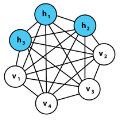Quantum annealing was originally proposed as an approach for solving combinatorial optimisation problems using quantum effects. D-Wave Systems has released a production model of quantum annealing hardware. However, the inherent noise and various environmental factors in the hardware hamper the determination of optimal solutions. In addition, the freezing effect in regions with weak quantum fluctuations generates outputs approximately following a Gibbs--Boltzmann distribution at an extremely low temperature. Thus, a quantum annealer may also serve as a fast sampler for the Ising spin-glass problem, and several studies have investigated Boltzmann machine learning using a quantum annealer. Previous developments have focused on comparing the performance in the standard distance of the resulting distributions between conventional methods in classical computers and sampling by a quantum annealer. In this study, we focused on the performance of a quantum annealer as a generative model. To evaluate its performance, we prepared a discriminator given by a neural network trained on an a priori dataset. The evaluation results show a higher performance of quantum annealing compared with the classical approach for Boltzmann machine learning.
翻译:D-Wave Systems 开发了一个量子射线硬件的生产模型。然而,硬件中固有的噪音和各种环境因素妨碍了最佳解决办法的确定。此外,量子波动弱的区域的冷冻效应产生产出,大约是在Gibbs-Boltzmann在极低温度下分布后产生的。因此,量子annealer 也可以作为Ising 旋玻璃问题快速采样器,一些研究还利用量子射线器调查了波尔茨曼机器学习情况。以前的开发侧重于比较传统计算机传统方法与量子射线器取样之间分配标准距离的性能。在本研究中,我们侧重于量子anner的性能作为基因化模型。为了评价其性能,我们编写了一个受先前数据集训练的神经网络提供的辨别器。评价结果显示,与波尔茨曼机器学习的古典方法相比,量子内射线的性能更高。




